
Shooting the Messenger: Why it’s important to let young people cut |
There is perhaps no phenomenon which contains so much destructive feeling as moral indignation, which permits envy or hate to be acted out under the guise of virtue.– Erich Fromm
Cutting and self-injury is all over the media lately, but because of its graphic nature, few who haven’t struggled with it themselves are able to think about it objectively, understand its roots, what makes it such an attractive path for some people, and how to turn it into something less destructive.
The most important thing to know about cutting is that cutting is not the problem. Cutting is a symptom of an underlying issue, as well as an attempt to survive that issue. It could be active abuse by a parent or partner. It could be work or school related stress. It could be unhappiness from not being socially better accepted or low-self esteem because a single stranger told them they were ugly when they were five years old. It could be as simple as they feel like they have no control over their lives and desperately want something to be inside their power. There are a million terrible things that can happen to a person, and from them a million reasons for cutting. Many cutters have built up such internal walls that they may not even be able to consciously face or name the things that make them cut. But, as murder victims scrawl out the name of the killer in their own blood, so do cutters inscribe the sins of their abusers in their flesh.
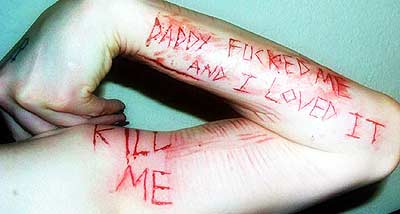
Song lyrics or accusation?
Below is a message I recently received about BME’s ritual cutting gallery.
|
hi, my names nicko, im 23, i just stumbled onto your sight and it’s cool, i really dig it, i’ve got 2 tats (traditional) and have always been into disturbing things so to speak, ever since that kid in 3rd grade eat ants i’ve been addicted to that OH MY GOD! feeling in your stomach where you think SICK! but some of the stories and images on your sight rub me the wrong way, dont get me wrong as horrified as i am by hanging by fish hooks, chemical burns,and scarification i understand that in a sterile professional enviroment it’s cool
but dont capitalise on the stories and pics of the cuttings and burnings that are from extreme abuse i read a story of a girl who burned im sorry into her leg, and pics of slicing a star in a leg that was obviously done at home, i didnt come to the site to get teary eyed and give a hug, you see where im getting at, dont go for the low blow, other than that great job.
and do you feel that posting these entries in the free area make it all the more dangerous for old cutters aswell as possible new ones waiting for the social exceptance that they need making the site, for a few, a place to show off there new so called pieces of art, im not a member and that is the reason, so here is where i tred into murky waters, dont you feel that your aiding destructive behavior? i knew a girl in high school who carved, and deep an (f-) f minus about 4 inches long and 2 inches wide above her fist to about her elbow, these are the ones that we have to protect as a society, and not give them a place to display there pain.
nicko k.
I get emails like this fairly regularly. I tried to ignore the generally insulting introduction and replied, “I totally understand where you’re coming from on this. I struggled with whether I should post these sorts of things for a long time. These people are already using cutting and ritual to somehow try and heal themselves. My hope is that by welcoming them into BME and by allowing them to talk about what they’re going through and what they do that they discover ways to channel those energies more positively.”
The worry that the images on BME could “trigger” people is a fairly common one. To that I replied, “it’s definitely a worry, and I know it must trigger some people. However, they’re being triggered because there’s something there boiling under the surface. Suppressing it and trying to hide it doesn’t make it go away — it lets it fester until it erupts, sometimes suicidally.”
I concluded by pointing out that “Stopping someone from talking about their pain doesn’t make it go away… That’s the most important thing to remember.”
The conversation then ended fairly typically, with threats and condemnation, and the clear message that the person I was talking to was utterly ignorant to everything I was saying. Below is their (or their mother’s) final message to me. I get several emails threatening me like this a week on various subjects, so I wasn’t that surprised:
|
Dear Heart,
Let me let you in on a little secret, before you were speaking to my son. Now you speaking to his MOTHER.
I just took the liberty of sending your website, and your e mails to the National Center for Missing and Exploited Children, the FBI, and every police center, and child abuse center I could find.
You sick witch. How dare you cover your sorry excuse for a human being self by saying you are helping children, or that you are not liable.
You are an opportunist. A exploiter of children. You hide yourself behind some ignorant wall of superiority, trying to rationalize what you are. Allow me to help you, you are the scum of the earth. A person who participates in exploiting children.
We’ll see what comes of my letters, and phone calls. You just met yourself a real woman, and a good mom.
I hope you spend a long time in jail.
Jane
Unfortunately it’s unempathic attitudes like these that underlie the causes of cutting in the first place, and when persisted in can drive young people to acts far worse than cutting: suicide or even Columbine-type shootings as desperate attempts to end the real source of the pain.

SILENCED
Now, I’m not a doctor, nor am I a therapist. Keep that in mind as you read this — it is not medical advice. I have however faced (and I think bested) cutting myself, and I have corresponded with thousands of people who’ve gone through the same.
Why people cut
To put it very clearly: most people cut because they are being abused mentally or physically and the cutting helps them survive by making them feel alive and by allowing them to be the one controlling the pain. This abuse can be current, past, or sometimes just day-to-day stresses piled up past the breaking point. The people arguing most strongly to silence cutters by attacking the act of cutting are often the abusers themselves — making it an act not unlike a Mob boss killing a witness — and because of the stigmas attached to cutting, self-righteous parents like “Ms. Cobra McThunders” end up further abusing battered young people — and protecting and enabling those that brought out their need to cut in the first place.
When animals are taken from their natural environment and imprisoned in small cages or otherwise have their normal lives stolen from them, they develop obsessive and self-harming behavior. They walk over and over in circles, they tear out their own hair, they chew their feet until they bleed, they stop eating, or they become violent. It should be patently obvious in these cases that their self-harming behavior is a direct result of their captors not meeting their basic needs. Humans are no different, and many cutters feel imprisoned, abused, and misunderstood by their parents and others in positions of power over them.
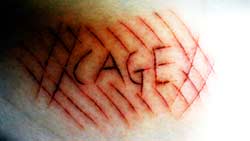
CAGE: “15 bars for 15 years”
If a person is cutting themselves, you can bet there’s something wrong in their life, either actively or as an unhealed wound from the past. Their cutting is both a desperate attempt to communicate this to anyone who can hear them, as well as an attempt to seize some control over a life that they feel little connection to or power over. It is better to hurt yourself than to have someone else hurt you — if you’re the one doing it, it’s under your control, and it’s your decision.
The issue of “triggering”
It is absolutely true that some people cut themselves after seeing the photos of other cuttings on BME. I’ve even received pictures of people cutting with their computer visible in the background, tuned to the cutting gallery. It wouldn’t surprise me if some of them cut for the first time after seeing those galleries. However, those galleries are never the cause itself.
If a person is cutting it means that they are trying to find a solution and they are trying to find a way to cope. It also means that they’re trying to find that solution inside themselves rather than the far more common solution of turning to drugs or external validation like abusive or promiscuous sex. You know what? I think it’s a good sign if a person chooses to cut themselves before turning to drugs. It’s not a permanent solution, but it’s a lot better than many of the darker options.
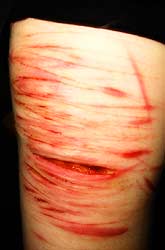
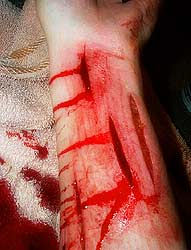
Now, don’t get me wrong. I don’t think it’s a good idea to cut. It’s dangerous, and it can leave you with marks that are extremely socially stigmatizing. It can also mask the real problem, give your abusers the excuse they need to compound the pain they already level at you, and even result in your psychiatric commitment or worse. Cutting is not a long term solution — but it is a warning that should be listened to, not silenced.
Imagine if people calling suicide hot-lines were hung up on because the operator sensed that they were in tears!
The real “cure” for cutting
If only the symptom (the cutting — which also serves as a survival tool) of a real problem is eliminated, then the person will try and resolve the problem in other ways — they may be driven to drugs, promiscuous sex, obsessive compulsive behavior, or even suicide — the third most common cause of death in teens. Under no circumstances is trying to force the cutting to end a solution in and of itself.

ALONE… LIES, PAIN… FEAR
I certainly concede that in most cases cutting is detrimental to a person’s life, but in the short term it is an essential safety net. However, in the long term it is equally essential that the cutter both try and find an alternative to cutting, and that ultimately they address the root cause. If the root cause is not addressed, the problems will escalate. I can not emphasize this enough. As long as the root stress is there (and there may be many different ones, and more may come in the future), the drive to cut will still be there. Thus, not only must the cause be addressed, but a better way to channel those energies must be found so the cutting does not repeat from the inevitable future wounds that all people face in life.
Alternatives to Cutting
It is very important to understand that cutting is a positive and life-affirming act which makes a person able to cope with their problems, albeit an act that is usually fueled by depression and almost always leads to other problems. However, the instinct to cut to feel, to cut to live, can not be cured any more than homosexuality can be “cured”. It is simply how some people naturally respond to certain kinds of stress. This can not be changed. That said, those of us who are cutters can — and must — learn to transform this symptom from something that potentially compounds the problem into something that not only makes our lives bearable, but actually improves our lives and makes us love being alive… even with the stresses.
Any crutch that is to replace cutting must retain that sense of empowerment and “aliveness”. There are two basic alternatives (I don’t consider medicating a person until they’re too numb to care a “solution”) — continue cutting but in a less stigmatizing form, or replacing the cutting with a totally different but equally satisfying act. The first option is probably more common among BME readers, and that is using guided body modification to channel those impulses into something that leaves an aesthetically pleasing result — scarification, tattoos, body piercings, and so on. With the aid of an experienced artist, the energies inside the cutter can be satiated through a form of cutting that results in subjectively beautiful artwork that helps a person to define themselves in an uplifting and empowering fashion. Many people find that this transition teaches them about the source of the problem, and assuming it isn’t ongoing, can heal the festering wounds that kept them cutting for so long.
This approach can also include cathartic acts such as suspension, play piercing, and flesh pulls to burn through those feelings in a supporting and safe context. However, in both of these cases it is important to keep in mind that the flaming rebirth of a phoenix from dead ashes to glorious life is not the same thing as the grim reaper deciding to wear a white robe instead of a black one. Or to speak less metaphorically, one should be wary about simply re-branding the problem into a more palatable form while leaving the compulsive behavior uncorrected.
In addition, not everyone wants to replace their cutting with another form of mutilatory self-medication. One solution that many people have tried successfully is exercise. Exercise connects a person to their body. Through the pain and effort, they become acutely aware of who they are and how they work, and most importantly, gain the realization that they have the power to transform themselves into anything they want to be. In many cases the resulting health and appearance benefits alone go a long way to solving underlying problems — as much as we inside this community try and distance ourselves from such statements, the fact is that beautiful people with beautiful bodies are not only more successful, but happier. Before you decide that is unfair, realize that every one of us can be beautiful if we just try.
I talked to former cutters who used exercise as a way to get their lives under control in a safer manner, and would like to share their comments here in their own words.
Currently I am studying for exams and the stress of it has exaggerated my tendency to self-injure. I don’t cut, I bite, scratch, and hit myself (but it amounts to the same thing — providing reassurance that I’m real, and giving me a sense of connection to my body). I have noticed that on the few days that I’ve chosen to do even a minimal amount of exercise the urge to self-injure has disappeared. For example, last week on the day before an exam, I walked briskly up and down my hundred foot garden fifty times. Afterwards I felt much more ‘of’ my body if that makes sense, and didn’t self-injure at one of the most high-risk times for self-injury for me.***
I used to cut, and when I decided to stop whenever I wanted to cut again I started doing push ups and sit ups for as long as I possibly could. It was one of the only things that could get me to calm down. It worked wonders.
***
I have a treadmill that I run on sometimes. The burn of the run and the thrill of the run are enough to satisfy my desires that are usually solved by cutting. Afterwards, I feel better about myself because I am making my body more fit and more attractive. I am becoming stronger.
***
I used to cut and then I got involved in boxing. It slowly weened me off of cutting, although I was coming out of weight rooms with bloody knuckles. But, I was also much more emotionally ‘stable’ afterwards because I had gotten a lot of “numbness” out of me. Eventually I weened myself off of boxing as well, and only use it when I am utterly outraged (once every couple months).
***
I am a cutter and have been for over fifteen years. This last winter was one of the toughest of my life and I reverted to cutting — breaking a solemn vow not to I made to my husband — to try and survive the stress. This spring, I joined a gym. The stresses are all still there; money, work, and postponed dreams. But I’m not cutting. I don’t like going to the gym, and the only thing keeping me going is a deep-seeded self-loathing, but I’m not cutting. And risking a little bit of muscle pull is a hell of a lot safer than risking severing a vein in a moment of distraction while cutting.
While one must be vigilant to avoid falling prey to obsessive exercise, a problem linked to cutting behavior which can be destructive to both health and self-esteem, some have argued that it is the lack of exercise in modern society that is one of the reasons for self-injury becoming more and more common. A person with a fit and maintained body feels alive, and it is far more rare for them to feel the need to seek out other approaches such as cutting.
If the pain that caused a person to cut was in the past, rather than ongoing, the solutions I’ve mentioned above can often heal those wounds due to the self-respect and self-esteem they help bloom. A happy person feels good about who they are and has little motivation to hurt themselves — although there’s still a very good chance that they’ll continue to “hurt” themselves in the process of body modification and ritual for self-improvement… Which is perfectly healthy and usually a sign that the individual is becoming more comfortable with who they are by taking a proactive role in defining their own identity.
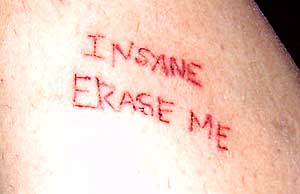
INSANE… ERASE ME
Although cutting is something that many wonderful people have gone through, it is not something you want to just let fester and continue. But it’s also not something you should be ashamed of. You can transform the energy that drives you to cut to improve your life, and that is what this article was about, and that is why BME has a cutting gallery.
Under no circumstances should a person ever be made to feel bad or be attacked because of their drive to cut. If a person is cutting, that means that they are trying to solve their problems and trying to open a dialog both internally and externally. The cuts are a signal that the desire and the foundation are there for healing to begin. The last thing we should do if we care about the person’s healing is to destroy that essential survival net.

Shannon Larratt
BME.com
 BME/News and Modblog highlight only a small fraction of what
BME/News and Modblog highlight only a small fraction of what
Why in the world was a 23 year old telling his mom on you?
But anyways, as someone that has gone through years of various forms of self harm, I can absolutely say one of the worst things to do is never talk about it. It just makes it so much more embarrassing and why would anyone say anything if they thought they were going to be attacked?
Its something young kids have become infatuated with, probably because people want it to stay a dark and scary secret, which I guess makes it exciting and a sort of rebellion.
Its such a relief when you can tell someone, looking them right in the eye, and they don’t even flinch. They just accept you and offer their support. You can’t fix pain with punishment. I wish more people understood that.
Before I start ranting on more, I commend you for not backing down. I think your message will help people, both the “harmers” and their loved ones.
Why in the world was a 23 year old telling his mom on you?
But anyways, as someone that has gone through years of various forms of self harm, I can absolutely say one of the worst things to do is never talk about it. It just makes it so much more embarrassing and why would anyone say anything if they thought they were going to be attacked?
Its something young kids have become infatuated with, probably because people want it to stay a dark and scary secret, which I guess makes it exciting and a sort of rebellion.
Its such a relief when you can tell someone, looking them right in the eye, and they don’t even flinch. They just accept you and offer their support. You can’t fix pain with punishment. I wish more people understood that.
Before I start ranting on more, I commend you for not backing down. I think your message will help people, both the “harmers” and their loved ones.
just do it (like the Nike advert tells you)
just do it (like the Nike advert tells you)